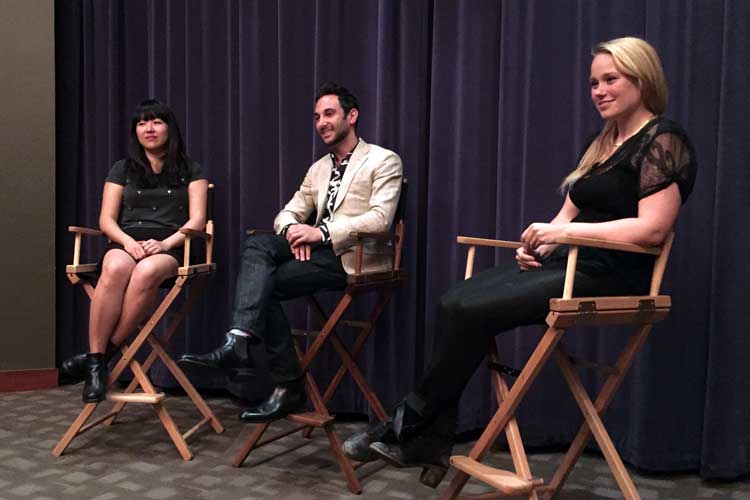The following questions and answers are excerpted from a conversation that followed the NBR screening of Those People.
Can you talk about some of the sources of inspiration for this film?
Joey Kuhn: I’ll start with the emotional inspiration for the film: In college, I accidentally fell in love with my gay best friend, and was afraid to tell him for years. You know, afraid of rejection, afraid of ruining the friendship. And while it definitely sucked at the time, it provided a lot of creative inspiration for this film, and a lot of emotion to dive into! I knew for my first feature I wanted to tell a coming-of-age story for a young gay man and have a romance at the center of it. So I thought that that friendship I had with my friend, that unrequited love, would be a good basis for a story. Because it’s about a guy who has to figure out who he is separate from other people, and why he can’t open himself up to this new exciting romance with the man of his dreams. The other thing that was very important to me was to show authentic representations of gay men my age. I think it’s very rare that we see ourselves reflected on screen. In the ’90’s we had a lot of coming out stories, or being in love with straight guys, and I just wanted it to be a story about men who happened to be gay. It was just one part of their identity. And then, when I started writing the script many years ago, you know the fall out from the Bernie Madoff scandal was still happening. And during this whole thing I was really drawn to the story of his son, Mark Madoff, who killed himself two years after his father was arrested. And I thought, here’s this guy whose life was ruined for something he maybe did not do. I like difficult characters in film, and I thought it’d be really interesting to explore that character through the eyes of someone who loved him the most. So I combined that inspiration with the experience I had with my best friend, and that’s how the script came about.
“I wanted him to literally be painting portraits of the people he’s thinking about.”
When dealing with the realities of making an independent film, how did you help each other keep your focus on the story? What were the things that mattered most to you as you began production?
Kimberly Parker: I think, for me, one of the most stressful days of the shoot was when we shot in the theater where Tim plays the piano for the first time… and then later they go back and they have their breakup scene. Because that is a gorgeous theater, and they were giving it to us for a discount, but there was a certain amount of time we had! There was a moment when we were at lunch and Joey said to me, “I didn’t get the breakup scene… I didn’t get it. I didn’t get Tim’s eyes.” And we were both just holding each other’s hands, so scared. We didn’t have enough extras. That theater could hold almost 4,000 people and we had something like 30 extras. Joey and our DP came up with a way to just make it work. Joey is easy to work with, because he’s willing to creatively solve problems. So while we couldn’t afford to pay 3,000 people to fill a theater, you just put the camera up on the balcony, you angle it so you see the bottom of the balcony in the quarter of the frame, and you fill that little part of the frame with people… and then it looks like a full theater. And then for the reverse shot you just move those same thirty people to a different part of the theater! It all worked out, but I remember a lot of stress on that day.
How did you determine what type of painter Charlie should be, and how did you go about creating the original art?
I knew that I wanted Charlie to be a figurative painter, because I wanted the audience to be able to track his feelings for the men in the film. So I wanted him to literally be painting portraits of the people he’s thinking about. Initially when I started the script he was an architect, and there was no outward expression of his feelings. I felt like making the character an artist was something that would be more interesting for the film. So once I decided he was going to be a figurative painter — and not modern — I at first reached out to a very famous artist named Hernan Bas, whom I love, and naively just asked him, “hey I’m doing this movie, could you do five original paintings, and twelve sketches…?” And he just said, “umm… No.” So then I started looking at all the different grad programs in New York and in surrounding states and I found this wonderful artist named Sam McKinniss, and saw his work and loved it. His story actually seemed very similar to Charlie’s, and I met him and he loved the script! And just like that he was onboard. He met with the three lead actors and drew them on the spot in person— it was really incredible. He went off and painted them, and painted the other characters based on photos. That was a really wonderful experience, working with him.

